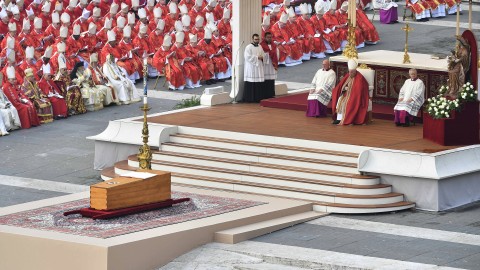Liturgy for Benedict’s funeral mass highlights unity in a divided church

Under a foggy gray sky on January 5, a historic funeral in St. Peter’s Square saw the sitting pontiff, Pope Francis, preside at a somber and simple ceremony for his predecessor, Emeritus Pope Benedict XVI, in a liturgy reflecting the rare situation of having had, for the past 10 years, two men in the Vatican with the title of pope.
Nearly 50,000 people, including some 3,700 priests, attended the mass, a noticeably smaller number than the usual crowd when a pope dies, but reflecting the relative obscurity of the last decade of Benedict’s life, spent in quiet retirement after he became the first pope to resign in 600 years.
Thursday’s mass was said in Latin, with the readings in English and Spanish, with Francis overseeing a liturgy that, according to James Bradley, a canon law expert at Catholic University of America and member of the Society for Catholic Liturgy, underlined a spirit of unity in the church and respect for Benedict’s former role.
The mass was celebrated in red vestments, traditionally only worn in recognition of a pope (instead of the black, purple, or white). Cardinal Giovanni Battista Re, the dean of the college of cardinals who was the main officiant, and the cardinals concelebrating the mass with him wore vestments made during Benedict’s reign, with his coat of arms embroidered at the bottom.
Francis, who did not celebrate the mass because of chronic pain in his right knee, used Benedict’s gold staff, called a ferula, rather than the one belonging to St. Paul VI that he normally uses.
“There were nice touches in the rite itself that acknowledged Pope Benedict’s own liturgical legacy,” Bradley said.
Witnessing a pope preside over the funeral of his predecessor is “unprecedented in modern times,” Bradley noted, saying that “what changed really was not the rite but the ceremonies accompanying the rite.”
Since Benedict was not reigning pontiff when he died, liturgists at the Vatican structured the mass in a way that took that into account while still reflecting that Benedict was once pope.
“That’s been done very carefully and in a very considered way but also recognizing that this is entirely new, and that people are just sort of feeling their way forward,” said Bradley.
One notable difference was that Benedict’s fisherman’s ring, symbolizing his papal authority, had already been broken after his resignation from the papacy in 2013, as is the practice when a pope dies.
But although the mass lacked the pomp and majesty that usually accompanies papal funerals, Benedict’s body was placed in the grottoes under St. Peter’s Basilica afterward as were his predecessors’, and in the traditional triple coffin accorded to popes.
The simplicity of the funeral focused attention on the liturgy itself, fittingly, Bradley said, for a pope who “saw the liturgy not ever as a point of division but always as a point of unity. This isn’t a church for Italy, or for France or for Spain, or for the 19th century, or for the 15th century, or the 21st century. It’s a church for all people at all times and at all places.”
In his homily, Francis hewed to the themes of resurrection as is common church practice at funerals and may have come across as straightforward and short to those who expected Francis to address the life and legacy of his predecessor. But in focusing on urging his listeners to pray for Benedict’s soul to go to heaven, said Bradley, Francis honored both custom and Benedict.
“Benedict never spoke about Benedict, he always spoke about Christ. I think Francis was carrying that through,” said Bradley. “He wasn’t seeking to make this about Benedict the man, that is for others to do at other times. The funeral is never the place for that.”
“God’s faithful people, gathered here, now accompanies and entrusts to him the life of the one who was their pastor,” Francis said in his homily. “Benedict, faithful friend of the bridegroom, may your joy be complete as you hear his voice, now and forever!”
Francis spoke on the reading from the Gospel of Luke, which recalled Jesus’ last words commending his spirit to God. “Holding fast to the Lord’s last words and to the witness of his entire life, we too, as an ecclesial community, want to follow in his steps and to commend our brother into the hands of the Father. May those merciful hands find his lamp alight with the oil of the Gospel that he spread and testified to for his entire life,” Francis said. —Religion News Service




